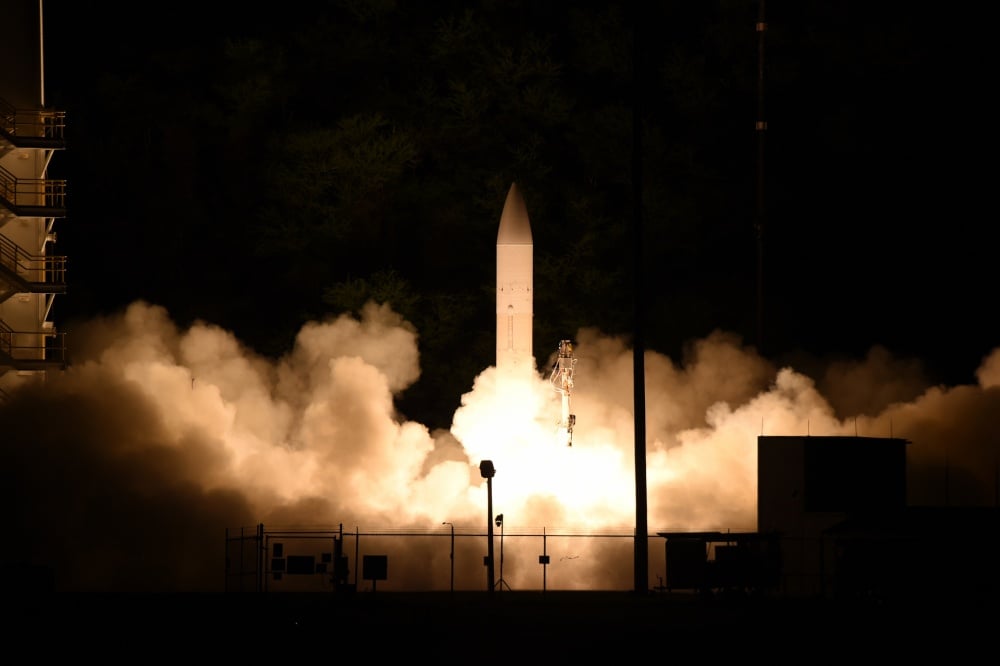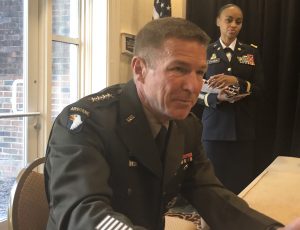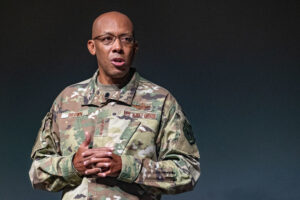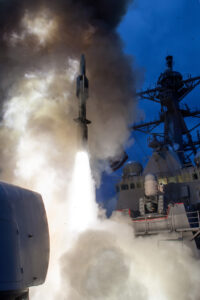
Launch of Army-Navy Common-Hypersonic Glide Body (C-HGB) in Hawaii on March 19, 2020.
WASHINGTON: The Army says its new long-range, land-based missiles will help Air Force and Navy strike planes, not compete with them — and despite traditional rivalries, some crucial Air Force and Navy leaders are listening.

Gen. James McConville
By building new Multi-Domain Task Force units armed with long-range missiles, “what we want to do as a service is provide the combatant commander…multiple options,” the Army Chief of Staff, Gen. James McConville, told the Defense Writers Group on Thursday.
And arguably the most important combatant commander out there, Navy Adm. Philip Davidson of Indo-Pacific Command, welcomed those new options in recent testimony to the Senate Armed Services Committee.
“A wider base of long-range precision fires… enabled by all our terrestrial forces — not just sea and air but by land forces as well — is critically important to stabilizing what is becoming a more unstable environment in the western Pacific,” Davidson told Sen. Tom Cotton. “Long-range precision fires delivered by the ground force, I think, are critically important.”
Even Davidson’s terminology is telling: “Long-Range Precision Fires” is the Army’s official term for the family of long-range weapons it’s developing. What are they? “They can range anywhere from hypersonic missiles to Mid-Range Capability to Precision Strike Missiles,” McConville said Thursday, “and these systems have the ability to penetrate anti-access/area denial [defenses and] in the future, to sink ships.”
It’s worth noting that “Mid-Range” in this context is at least a thousand miles; hypersonics would fly much farther. Even the shortest-range item on McConville’s menu, the Precision Strike Missile (PRSM), has a range of over 300 miles, which is greater than the longest-range missile in the Army’s inventory today, the Cold War ATACMS.

Air Force Chief of Staff Gen. CQ Brown
But wait a minute – isn’t it the job of tactical fighters and, especially, Air Force bombers to penetrate enemy air defenses and strike deep into hostile territory? Key Air Force leaders have pushed back, albeit obliquely, defending their service’s primacy in long-range strike and hinting a ground-based capability would be both redundant and inferior.
No less a figure than the Air Force Chief of Staff, Gen. Charles Brown – a former commander in the Pacific himself – said last month he’d talked with McConville about long-range fires. “We both provide that capability, as well as the other services,” Brown said, “[so as] we look at gaps and seams and overlaps in capability, this is what the discussion has to occur on with [respect to] roles and missions.”
Air Force Gen. John Hyten, vice chairman of the Joint Chiefs of Staff, also used to want a review of the services roles & missions laid down by the Key West Agreement of 1948 – used to. But last month, he said he now considers it premature to try to lock down service roles when we’re still figuring out how they’ll work together in future Joint All Domain Operations.
“Four years ago … I advocated for a roles and missions discussion on those issues,” Hyten said when CSIS scholar Tom Karako asked him about long-range land-based fires. “As I came in and started working deep into the Joint Warfighting Concept, I realized that, number one, we actually don’t have to do that, and you don’t have to do that because of the way the nature of war is changing.”

Gen. John Hytene
“In the Joint Warfighting Concept, the critical structure is basically expanded maneuver – maneuver in every domain, every structure, every command,” Hyten told the CSIS webcast in February. “[Even] our ground forces have to move faster than the adversary, and they have to be able to defend themselves wherever they go and attack effectively.”
“As you walk through that expanded-maneuver concept… son of a gun, all the lines on the battlefield disappear,” Hyten exclaimed. While he didn’t explicitly mention it, many officers have said that includes the traditional boundaries – like the Fire Support Coordination Line – that leave targets on the far side for airpower and on the near side for artillery.
Among “my brothers and sisters in the Air Force,” Hyten said, “there’s a couple that are arguing pretty aggressively for a kind of a roles and missions look. But that’s looking at the world from 1948. We’ve got to look at the world from 2021.”
That’s as close to a rebuke for his own service as Hyten can publicly come. Karako, the general’s interlocutor at CSIS, put it more bluntly in an email to Breaking Defense:
“Given that the new Joint Warfighting Concept has yet to emerge, it seems premature to toss objections about roles and missions dating back seven decades,” Karako told me. “In this new missile age, this new era of standoff, multiple services may well need to field long-range hypersonic, supersonic, or subsonic strike. Admiral Davidson reaffirmed such a vision… by endorsing the utility of ground-based long-range fires operated by the Army and the Marines.”

Tom Karako
“This might not fit the traditional roles and missions division of labor, but it probably shouldn’t,” Karako said. “As General Hyten put it, cautioning his own Air Force colleagues, it’s not 1948 anymore.”
Now, there’s absolutely a debate to be had about the advantages and disadvantages of airstrikes versus land-based missiles. A bomber is absolutely the most flexible efficient way of delivering munitions to multiple targets: Instead of building a one-use rocket that can fly hundreds or thousands of miles, you have a reusable aircraft that can fly overhead and fire large numbers of smaller, cheaper short-range missiles, or just drop precision-guided bombs that need no propellant besides gravity.
But that’s assuming the bomber can get through. China and Russia have invested massively in anti-aircraft defenses in recent decades. They’ve also invested in long-range anti-ship missiles as well to hold off American aircraft carriers and Tomahawk-missile-launching surface warships. (Submarines are a harder target). Land-based launchers, by contrast, can hide in jungles or tunnels on Pacific islands that – as McConville noted – no enemy can sink.

Raytheon’s SM-6 missile
So, McConville and his camp argue, there will be times when Army weapons can open the way. If your long-range missile is intercepted and shot down, well, at least you didn’t lose the lives of expensively trained aircrew. If it gets through, it can blow up anti-aircraft defenses to open a path for airpower.
“We’re going to need in the future the ability to maybe suppress air defense, and we’re going to do it maybe from a strategic range,” McConville said – that is, with long-range, land-based weapons. The Army (and Marines) are also working to sink enemy ships with land-based missiles, he said. So, he summed up, “what we’re doing is providing an option that may in the future enable both air and maritime maneuver.”
But the Air Force, for its part, has very pointedly been prioritizing its modernization efforts aimed at overcoming higher-threat air environments. This includes the Next Generation Air Dominance (NGAD) program, which is considering development of not just a sixth-generation fighter, but also lower-cost aircraft (known as “attritable” in Air Force jargon) to take on the suppression of enemy air defense (SEAD) mission perhaps using AI pilots..
The related Skyborg program has been looking at the concept of teaming piloted aircraft with drones for various missions; and on March 5 the service issued a request for information (RFI) on a potential new family of Next-Generation Multi-Role Unmanned Aerial System Family of Systems (UAS FoS) that could include “expendable” drones. Among the mission sets foreseen, are “a new use for UAS FoS in anti-access and area denial environments while offering efficiencies in meeting capacity needs of combatant commanders.”
All this costs money, and there’s less to go around among the services. So the big question is going to be, can the Pentagon afford multiple long range options? “The cost is fairly reasonable for the capability that’s going to be brought,” McConville said.
It’s worth noting that the Army isn’t reinventing the wheel here. Its longest-range weapon, the hypersonic missile, shares both warhead (aka “glide body”) and booster rocket with the Navy version: They’re just packaged differently to launch from trucks instead of ships. And the modestly named Mid-Range Capability, with its thousand-mile range, will use a mix of existing Navy missiles, the subsonic Tomahawk and the supersonic SM-6, to handle different targets.
Davidson referenced this repurposing in his endorsement of the Army plan. “I’ve been encouraged by the enthusiasm by the Army and the Marine Corps to embrace some of the capabilities that the Navy and Air Force have already developed,” he said. “I think that is a low cost way to quick capability that can be fielded potentially in the region, and I think we ought to stay after it.”






















